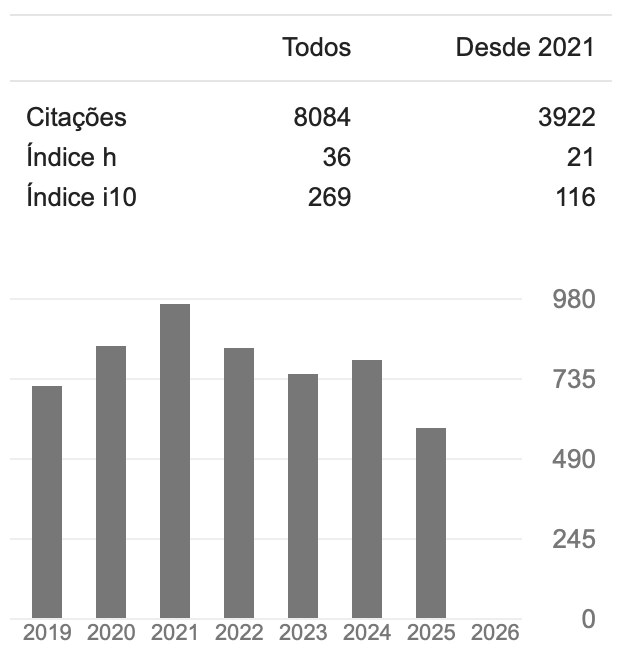Correlação entre a qualidade de vida e a capacidade funcional em pacientes com esclerose múltipla
DOI:
https://doi.org/10.17765/2176-9206.2021v14n2e7654Palavras-chave:
Esclerose múltipla, Incapacidades, Qualidade de vidaResumo
A esclerose múltipla (EM) é uma doença crônica inflamatória e desmielinizante do sistema nervoso central, levando a incapacidades funcionais e sociais e piora da qualidade de vida dos indivíduos. O objetivo deste trabalho foi verificar a correlação entre a qualidade de vida e o grau de acometimento funcional de paciente com EM. Trata-se de um estudo do tipo transversal, descritivo e quantitativo. Foi utilizado a The World Health Organization Qualityof Life (WHOQOL - BREF) para avaliação da qualidade de vida, e a Expanded Disability Status Scale (EDSS) para avaliação das incapacidades. Foram analisados 34 indivíduos com EM, com média de idade de 41,14 anos e com predomínio do gênero feminino (61,76%). Dessa amostra, 76,47% apresentaram a forma clinica remitente-recorrente, e a média da EDSS foi de 2,95, com pontos de correlação estatisticamente significante entre EDSS e WHOQOOL-BREF. Conclui-se que nesse grupo estudado existem pontos de correlação entre a qualidade de vida e as incapacidades decorrentes da doença.Downloads
Referências
1. Toro GJ, Patiño J, Reyes S, Rivera JS, Ríos J, Noriega D. Qué se debe saber en esclerosis múltiple: 16 preguntas prácticas.J Acta Neurológica Colombiana. 2019;35:40-9.
2. Akbari Z, Taheri M, Jafari A, Sayad A. FOXP3 gene expression in the blood of Iranian multiple sclerosis patients. Hum Antibodies. 2017;26(3):159-64.
3. Pimentel P, Toldrá R. Desenvolvimento de manual para orientações básicas do dia a dia para pessoas com esclerose múltipla. CadTer OcupUFSCar. 2017;25:67-4.
4. Halabchi F, Alizadeh Z, Sahraian MA, Abolhasani M. Exercise prescription for patients with multiple sclerosis; potential benefits and practical recommendations. BMC Neurology. 2017;17(1):185.
5. Razazian N, Yavari Z, Farnia V, Azizi A, Kordavani L, Bahmani DS, et al. Exercising impacts on fatigue, depression, and paresthesia in female patients with multiple sclerosis. Medicine and science in sports and exercise. 2016;48(5):796-803.
6. Satue M, Rodrigo MJ, Otin S, Bambo MP, Fuertes MI, Ara JR, et al. Relationship between visual dysfunction and retinal changes in patients with multiple sclerosis. PloS one. 2016;11(6):e0157293.
7. Boonstra F, Florescu G, Evans A, Steward C, Mitchell P, Desmond P, et al. Tremor in multiple sclerosis is associated with cerebello-thalamic pathology. Journal of neural transmission (Vienna, Austria: 1996). 2017;124(12):1509-14.
8. Salci Y, Fil A, Armutlu K, Yildiz FG, Kurne A, Aksoy S, et al. Effects of different exercise modalities on ataxia in multiple sclerosis patients: a randomized controlled study. Disability and rehabilitation. 2017;39(26):2626-32.
9. Tome ALF, Miranda EP, Bessa J Junior, Bezerra CA, Pompeo ACL, Glina S, et al. Lower urinary tract symptoms and sexual dysfunction in men with multiple sclerosis. Clinics (Sao Paulo). 2019;74:e713.
10. Liu M, Fan S, Xu Y, Cui L. Non-invasive brain stimulation for fatigue in multiple sclerosis patients: A systematic review and meta-analysis. Multiple Sclerosis and Related Disorders. 2019;36:101375.
11. Finkelsztejn A, Lopes J, Noal J, Finkelsztejn J. The prevalence of multiple sclerosis in Santa Maria, Rio Grande do Sul, Brazil. ArqNeuropsiquiatr. 2014;72:104-6.
12. Ribeiro SB, Maia DF, Ribeiro JB, Cardoso FA, Silva C. Clinical and epidemiological profile of patients with multiple sclerosis in Uberaba, Minas Gerais, Brazil. Arq Neuropsiquiatr. 2011;69(2a):184-7.
13. Lublin FD, Reingold SC, Cohen JA, Cutter GR, Sørensen PS, Thompson AJ, et al. Defining the clinical course of multiple sclerosis: the 2013 revisions. Neurology. 2014;83(3):278-86.
14. Rosé CT, Camila LN. Application study of the components Activity and Participation of the ICF Checklist used in people with multiple sclerosis and its relation to the Core Sets. CadTer Ocup. 2016;24(4):723-32.
15. Brasil. Ministério da Saúde. Biblioteca Virtual em Saúde do Ministério da Saúde [Internet]. 2103 [citado em 2018 ago. 19].Disponívelem:https://bvsms.saude.gov.br/bvs/dicas/260_qualidade_de_vida.html
16. Fleck MP, Louzada S, Xavier M, Chachamovich E, Vieira G, Santos L, et al. Application of the Portuguese version of the instrument for the assessment of quality of life of the World Health Organization (WHOQOL-100). Rev Saúde Pública. 1999;33(2):198-205.
17. Felipe E, Mendes MF, Moreira MA, Tilbery CP. Análise comparativa entre duas escalas de avaliação clínica na esclerose múltipla: revisão de 302 casos.ArqNeuropsiquiatr. 2000;58:300-3.
18. Nogales-Gaete J, Aracena R, Cepeda-Zumaeta S, Eloiza C, Agurto P, Díaz V, et al. Esclerosis múltiple recurrente remitente en el sector público de salud de Chile: Descripción clínica de 314 pacientes . J Revista médica de Chile. 2014;142:559-66.
19. Papuc E, Stelmasiak Z. Factors predicting quality of life in a group of Polish subjects with multiple sclerosis: accounting for functional state, socio-demographic and clinical factors. Clinical neurology and neurosurgery. 2012;114(4):341-6.
20. Finkelsztejn A, Cristovam RA, Moraes GS, Lopes MG, Silva AV, Garcia MS, et al. Clinical features of multiple sclerosis in the south of Brazil: a partial analysis. Arq Neuropsiquiatr. 2009;67(4):1071-5.
21. Alshubaili AF, Ohaeri JU, Awadalla AW, Mabrouk AA. Quality of life in multiple sclerosis: a Kuwaiti MSQOL-54 experience. Acta neurologica Scandinavica. 2008;117(6):384-92.
22. Fritz NE, Roy S, Keller J, Prince J, Calabresi PA, Zackowski KM. Pain, cognition and quality of life associate with structural measures of brain volume loss in multiple sclerosis. NeuroRehabilitation. 2016;39(4):535-44.
23. Blikman LJ, van Meeteren J, Twisk JW, de Laat FA, de Groot V, Beckerman H, et al. Effectiveness of energy conservation management on fatigue and participation in multiple sclerosis: A randomized controlled trial. Multiple sclerosis (Houndmills, Basingstoke, England). 2017;23(11):1527-41.
24. Comber L, Galvin R, Coote S. Gait deficits in people with multiple sclerosis: A systematic review and meta-analysis. Gait & posture. 2017;51:25-35.
25. Twork S, Wiesmeth S, Spindler M, Wirtz M, Schipper S, Pohlau D, et al. Disability status and quality of life in multiple sclerosis: non-linearity of the Expanded Disability Status Scale (EDSS). Health and quality of life outcomes. 2010;8:55.
26. Wynia K, van Wijlen AT, Middel B, Reijneveld SA, Meilof JF. Change in disability profile and quality of life in multiple sclerosis patients: a five-year longitudinal study using the Multiple Sclerosis Impact Profile (MSIP). Multiple sclerosis (Houndmills, Basingstoke, England). 2012;18(5):654-61.
27. Pakpour AH, Yekaninejad MS, Mohammadi NK, Molsted S, Zarei F, Patti F, et al. Health-related quality of life in Iranian patients with multiple sclerosis: a cross-cultural study. Neurologia i neurochirurgia polska. 2009;43(6):517-26.
28. Brands I, Bol Y, Stapert S, Kohler S, van Heugten C. Is the effect of coping styles disease specific? Relationships with emotional distress and quality of life in acquired brain injury and multiple sclerosis. Clinical rehabilitation. 2018;32(1):116-26.
29. Lynning M, Hanehoj K, Karnoe Knudsen A, Skovgaard L. Self-care activities among people with multiple sclerosis in Denmark: Use and User Characteristics. Complementary Medicine Research. 2017;24(4):240-5.
Arquivos adicionais
Publicado
Como Citar
Edição
Seção
Licença
A submissão de originais para a revista Saúde e Pesquisa implica na transferência da Carta Concessão de Direitos Autorais, pelos autores, dos direitos de publicação digital para a revista após serem informados do aceite de publicação.A Secretaria Editorial irá fornecer da um modelo de Carta de Concessão de Direitos Autorais, indicando o cumprimento integral de princípios éticos e legislação específica. Os direitos autorais dos artigos publicados nesta revista são de direito do autor, com direitos da revista sobre a primeira publicação. Os autores somente poderão utilizar os mesmos resultados em outras publicações, indicando claramente a revista Saúde e Pesquisa como o meio da publicação original. Em virtude de tratar-se de um periódico de acesso aberto, é permitido o uso gratuito dos artigos, principalmente em aplicações educacionais e científicas, desde que citada a fonte. A Saúde e Pesquisa adota a licença Creative Commons Attribution 4.0 International.
A revista se reserva o direito de efetuar, nos originais, alterações de ordem normativa, ortográfica e gramatical, com vistas a manter o padrão culto da língua e a credibilidade do veículo. Respeitará, no entanto, o estilo de escrever dos autores. Alterações, correções ou sugestões de ordem conceitual serão encaminhadas aos autores, quando necessário. Nesses casos, os artigos, depois de adequados, deverão ser submetidos a nova apreciação. As opiniões emitidas pelos autores dos artigos são de sua exclusiva responsabilidade.


















